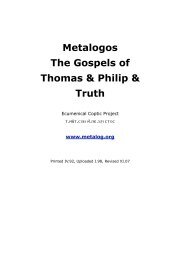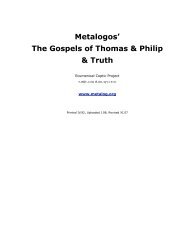Andrew Louth - Syriac Christian Church
Andrew Louth - Syriac Christian Church
Andrew Louth - Syriac Christian Church
You also want an ePaper? Increase the reach of your titles
YUMPU automatically turns print PDFs into web optimized ePapers that Google loves.
LIFE AND TIMES 11<br />
23) did not like the sound of it, but in Constantinople there were those,<br />
including the Emperor’s nephew and eventual successor Justinian,<br />
who saw in this formula the possibility of a breakthrough. From the<br />
time of Justinian’s accession in 527 this formula—the so-called<br />
‘theopaschite’ formula—became the centre-piece of an attempt to<br />
achieve unity between the divided parties in the East and also with<br />
Rome. This theological position-once called ‘Neochalcedonianism’, but<br />
now more commonly called ‘Cyrilline Chalcedonianism’— attempted<br />
to interpret Chalcedon in the light of the teaching of Cyril, and in<br />
particular his stress that the person of the Incarnation was God the<br />
Word, ‘one of the Trinity’, and that everything the Incarnate One<br />
experienced, including his sufferings, was to be ascribed to the divine<br />
person of the union. This was not simply a compromise formula: the<br />
appeal of Cyril (acclaimed in the seventh century by Anastasius of<br />
Sinai as the ‘seal of the Fathers’) was genuine, and even during the<br />
Acacian schism there had been an attempt by John of Caesarea to<br />
defend the Chalcedonian Definition as consonant with the teaching of<br />
Cyril, and largely expressed in his own words (taken out of context, as<br />
Severus retorted in his response to John). In the 530s Justinian sought<br />
to achieve unity on this basis: he failed, not least because there were<br />
enough rival bishops in various sees in the East to cause practical<br />
problems. The consecration in 543 of Jacob Baradaeus (Burd‘ono) as<br />
Bishop of Edessa and his indefatigable enthusiasm in establishing a<br />
rival episcopal hierarchy of ‘Jacobites’ or ‘Monophysites’ (as their<br />
enemies called them) finally put paid to Justinian’s efforts. Having<br />
failed to achieve union by negotiation, Justinian turned to persecution:<br />
the sufferings of the Monophysites only confirmed them in their<br />
beliefs and further deepened the divisions in the East, in Syria and<br />
Egypt for the most part. 16<br />
But Justinian’s ‘Cyrilline Chalcedonianism’ was more than a tactical<br />
compromise: it represented to him and many others a necessary<br />
clarification of Chalcedon. At the fifth Ecumenical Council, held at<br />
Constantinople in 553, it received conciliar authority: according to the<br />
tenth anathema, ‘If anyone does not confess that our Lord Jesus<br />
Christ, who was crucified in the flesh, is true God and Lord of Glory<br />
and one of the Holy Trinity, let him be anathema!’ 17 It was also<br />
enshrined in a hymn, ‘Only-begotten Son’, attributed to Justinian<br />
himself, and still sung at each celebration of the liturgy in the<br />
Orthodox <strong>Church</strong>: ‘You were crucified, Christ God, trampling death by<br />
death, being one of the Holy Trinity,…save us!’ Justinian’s efforts<br />
were not perhaps entirely fruitless. The Monophysites themselves had<br />
problems of unity and particularly during the reigns of Justin II (565–<br />
78) and Tiberius I (578–82) some of the leaders of the Syrian<br />
Monophysites were tempted to join the Orthodox (Imperial) <strong>Church</strong>. 18




